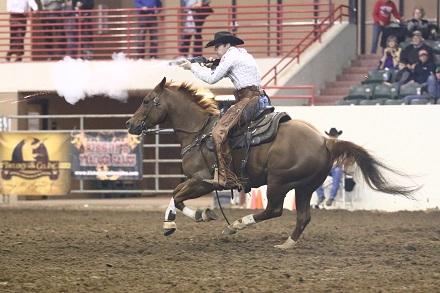
The Cowboy Mounted Shooting Association® represents one of the fastest-growing equestrian disciplines in the nation. Mounted contestants compete in timed events using two .45 caliber single action revolvers each loaded with five rounds of specially prepared blank ammunition. The rider must navigate a given course, successfully shooting balloons as he or she goes. CMSA has a variety of levels of competition for everyone, ranging from novice levels to seasoned professionals.
Competitors dress in traditional western style or in the style of the late 1800s. Children as young as ages four or five may compete in a limited manner; they are led through the course on horseback by their parents and can practice by aiming cap pistols at the balloons; later, they can actually fire at balloons while standing on the ground, again accompanied by parents. All established competitors use cartridges called .45 caliber Long Colts. The brass cartridge is loaded with black powder (like that used in the 1800s). This load will break a balloon up to about 15 feet. Live rounds are strictly prohibited at competitions. The firearms used must be .45 caliber single action revolvers reminiscent of those used in the late 1800s.
CMSA athletes compete throughout the year at the local or club level. The CMSA Wrangler World Championship is held over the course of four days in October; this year, it is in Amarillo, Texas. The Winter U.S. Championship is held in mid-February in Queen Creek, Arizona. Nationals are held in April; they will next be held over eight days in Tunica, Mississippi. (There are also championship events for the Central, Eastern and Western regions of the U.S.) Information on all upcoming events can be found here.
Sports Destination Management: Cowboy mounted shooting is really taking off. Is it a new sport, or new-ish?
Mark Marley: It has been around about 20 years. Its roots go back to 1995, to Arizona.
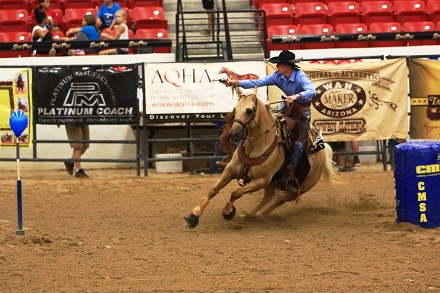
SDM: Is it club-driven at the school level?
Marley: We have over 100 clubs in the United States and Canada – those are mostly local clubs. There’s not really anything through the schools at this point. It doesn’t have to be club-driven for people to participate, but the clubs produce the events and they’re the ones who are really exposing the sport to new people.
SDM: Is it a discipline of rodeo?
Marley: No, it’s completely separate – its own standalone event. In some people’s eyes, it gets lumped in with rodeo, but it’s typically not offered during rodeos themselves, the way calf roping or barrel racing would be. You might see a fair that is also offering a rodeo hold a cowboy mounted shooting competition or a demo of the sport, but again, it’s a separate thing.
SDM: Who takes part in the sport – is it more heavily participated in by one gender?
Marley: We’re close to 50/50 in gender and some of the top cowboys are actually cowgirls. We try to split our competitions so it’s guy vs. guy and girl vs. girl. At the top end, the girls will take on the guys without any questions. In the lower levels, though, women who are just getting started might be a little intimidated about competing against men.
SDM: What is the age demographic like?
Marley: We have a broad range of ages – as young as four or five being led through the course by their parents, with a handful of competitors in their 80s. We do see fewer young adults – people who are just starting families or just starting their careers – and we have a lot of teenagers.
SDM: Why is the sport so popular?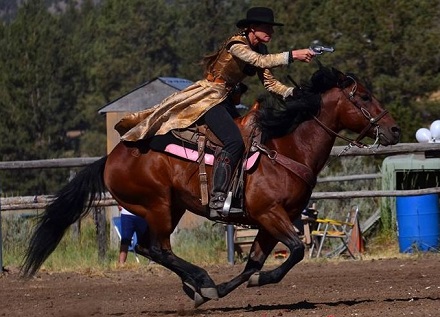
Marley: It’s fun and there’s just a huge family aspect to it. That’s how I got involved. My daughter got into it, and then she got dad started, as well as her brother and her mom even did it some. It was interesting in that we had one kid in high school and one in college when we started, and our son would come home from college to do this rather than staying in a college town for the weekend – where, of course, there were all kinds of things to do. In fact, we’ve seen several families where the child, the parents and the grandparents have all been competing.
SDM: Geographically, what is the distribution of the sport?
Marley: We’re scattered throughout the country. Probably the South and Southwest is where the sport is more prevalent but it’s growing in the East and Northeast more and more.
SDM: How do people find out about it? From friends? From magazines?
Marley: They learn about it everywhere – some people will see it on livestream on the Internet or hear of someone doing it or they’ll see it at a fair and want to try.
SDM: Let’s talk a little bit about the event side of it. From looking at your calendar, it appears there are events going on all time.
Marley: CMSA sanctions over 600 events per year. Most are at the club level. We produce our National and World events.
SDM: What are you looking for when you’re looking for a venue to host those types of events?
Marley: One of the things we look for is indoor arenas – we need to be protected from the elements. The size of the arena is important too since anything too small is going to be challenging. We need to have RV space since many of our families travel around in those. Obviously, you need stalls for horses, and you need something in close proximity to town, so people can find restaurants and shopping if they need it. It’s similar to any other equine event, really; you need the infrastructure to accommodate the event.
SDM: Any ideas on how many people attend the bigger events?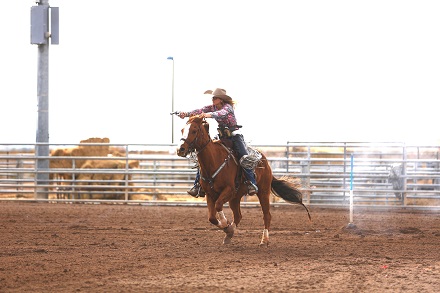
Marley: Each event is different. We’ve done some studies, but for our event in Amarillo, we’ll have between 360-400 athletes coming into town. Then you have to figure that each of those people, if they’re a teenager or a kid, will be bringing at least one parent, and you have a fairly good impact to the economy of the town, especially if an event lasts several days.
SDM: Is a certain type of breed of horse that is preferable for cowboy mounted shooting?
Marley: No, but you do need an athletic horse if you want to be competitive. The horse needs to be trained in mounted shooting as they would in any other equestrian sport; they have to be used to being ridden in an arena, and they need to be used to the sound of the gunfire, the balloons, that sort of thing. There are over 60 patterns in our rule book. Some are simple and some are complicated, so a horse would need to be athletic and agile in order to be able to excel with the rider as a team.
SDM: It sounds like it’s very competitive.
Marley: It is, but it’s also fun. Mounted shooting families are some of the best people you’ll ever meet. They will lend you a horse, lend you guns, fix your trailer, do whatever they can to help. They are competitive, and they want to beat you, but they’ll also help you any way they can.
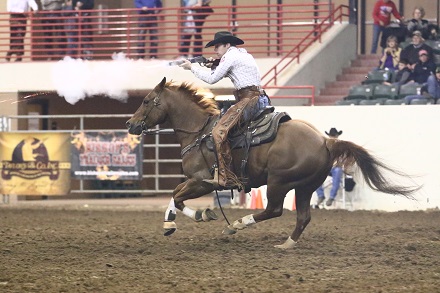 SDM: What surprises people most about the sport?
SDM: What surprises people most about the sport?
Marley: It’s a lot more challenging than most people realize. They watch someone do it and they think, ‘Well, that doesn’t look hard,’ but when you are in the back of a horse and there’s a course you have to follow and a gun in your hand and you’re moving fast, it’s very different. It’s a blast to do, though. And you know, it’s not the shots you hit that make you think; it’s the ones you miss. You can spend a while thinking, ‘How did I miss that balloon?’ It makes you want to do better next time.

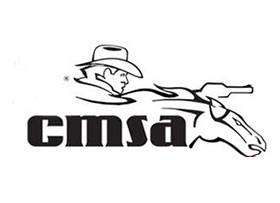 www.cmsaevents.com
www.cmsaevents.com